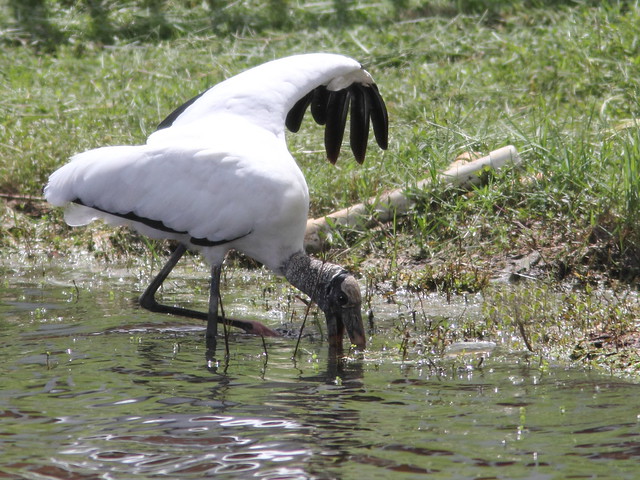Posted by: Ken @ 8:52 pm
This past week, it may have been just a coincidence, but a cormorant and a stork were feeding quite close to each other at the corner of our lake, in the yard next door.
Double-crested Cormorant:
It is possible that both birds derived mutual benefit, as the stork might have caused larger fish to move away from the shore into deeper waters where the cormorant (a sight feeder) could more easily catch them. The stork might benefit because smaller fish may have been driven closer to where the stork (a tactile feeder) could clamp its jaws when they came into contact with its beak. Note also how the stork stirs the water with one foot while holding its wing up to shade the water around its bill. Its “bubble-gum pink” feet may also resemble worms to attract the fish. As I have discussed in earlier posts, the water level is critical to the success of the stork’s feeding technique. It must be at least halfway up its bill, but cannot be deeper than its eyes.
Wood Stork:
Small fish are believed to seek shelter in the shade. Herons are sight feeders, and some (such as the Tricolored Heron and the Reddish Egret) commonly use this same tactic, in order to cut down on reflection and also possibly concentrate prey in the shadow of its wings. (DISCLAIMER– I had to edit out a beer can that occupied the bank just in front of the stork’s bill.)
Here are examples of a Tricolored Heron and also an immature Reddish Egret using their wings to shade the water in front of them:
The Reddish Egret even created an “umbrella” that completely shaded its body:
Earlier this year, I documented the varied reptilian fare of a stork, an ibis and a Great Egret (see: White Waders 3, Herps 0). I observed a stork as it captured a frog– to me, it appeared to actually strike out and grab the amphibian, but perhaps its bill encountered the frog randomly and its capture was a reflex action. In this case, the stork was hunting alongside a Great Egret. White Ibises, also tactile feeders, are not as sensitive to water levels. Here, they are probing in the moist soil in our lawn at the lake’s edge. I have seen them chase down snakes, lizards and insects, so they can use vision in acquiring prey.
Ibises often forage in groups, and this likely improves their hunting success:
You may be interested in my post Sharing the Table: Commensalism. In ecology, commensalism is a class of relationship between two organisms where one organism benefits but the other is unaffected. There are three other types of association: mutualism (where both organisms benefit), competition (where both organisms are harmed), and parasitism (one organism benefits and the other one is harmed).
Commensalism derives from the English word commensal, meaning “sharing of food” in human social interaction, which in turn derives from the Latin cum mensa, meaning “sharing a table”. Originally, the term was used to describe the use of waste food by second animals, like the carcass eaters (such as vultures and hyenas) that follow hunting animals but wait until the latter have finished their meal.
Next to Chapel Trail Nature Center near our Florida home, Cattle Egrets cluster around cattle, reaping the benefits of their association as the bovines attract insects and also stir them up as they feed:
Also in our back yard lake, a Great Egret and a Wood Stork mutually benefited as another Double-crested Cormorant fished just offshore. Fish, frightened by the activities of the cormorant, fled in all directions. They blundered into the waiting open jaws of the stork as the tactile feeder waited blindly until sensing the hapless fish that bumped into its bill:

Three years ago I described the behavior of this Tricolored Heron, that associated with a group of Red-breasted Mergansers. All moved around the perimeter of our lake. Sometimes the heron seemed to be following the mergansers, but at other times the heron appeared to attract them by finding fish first.



















